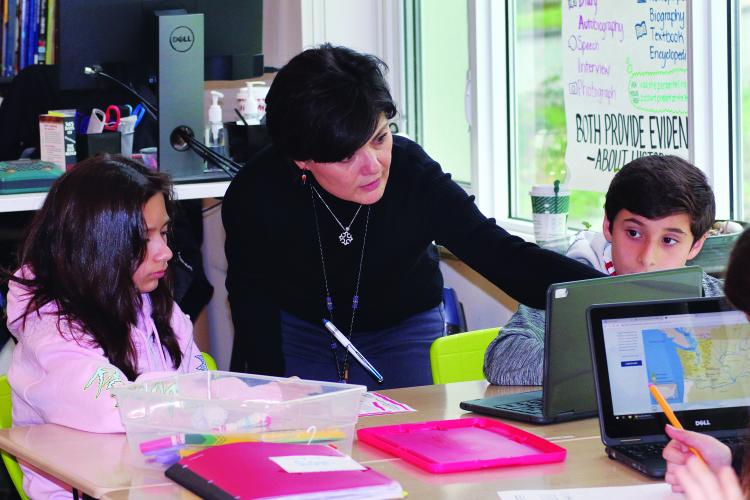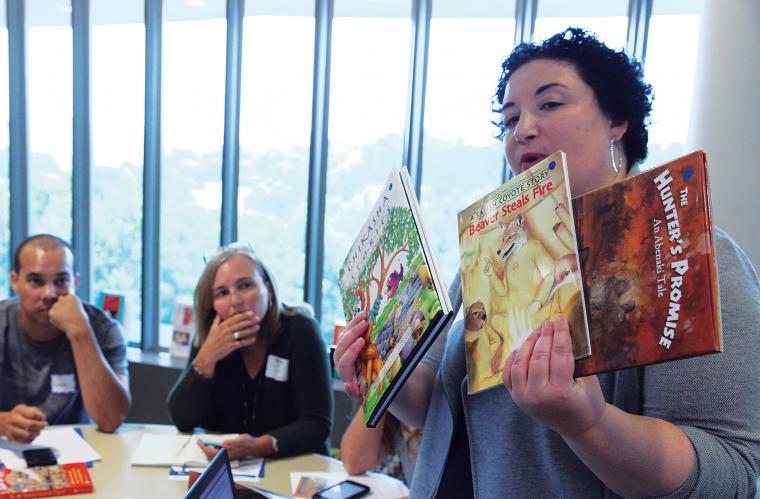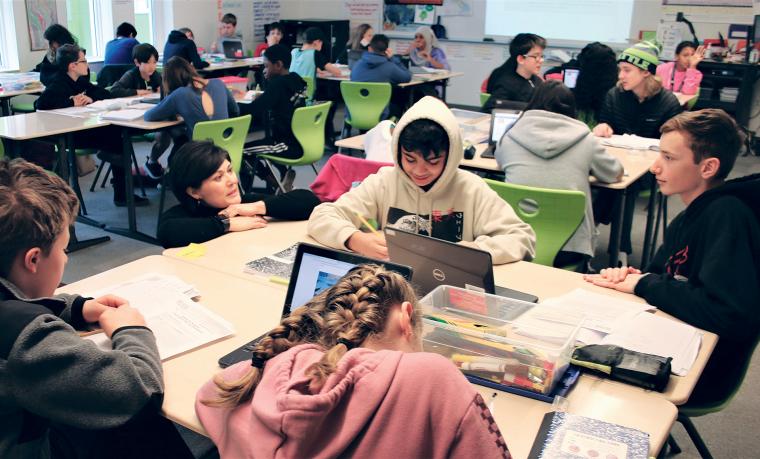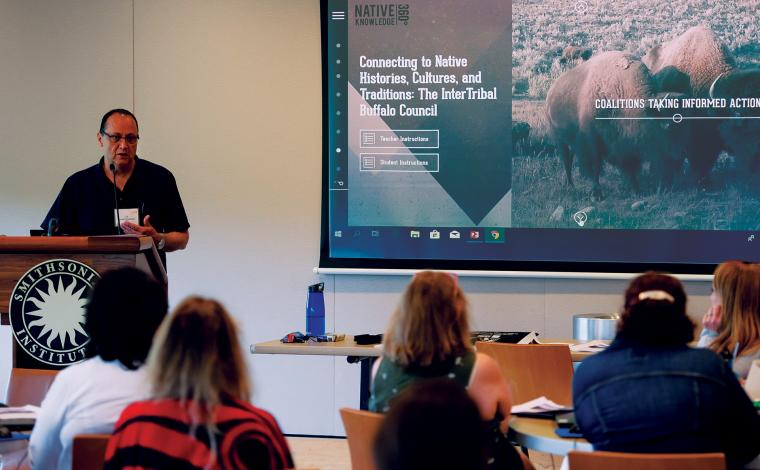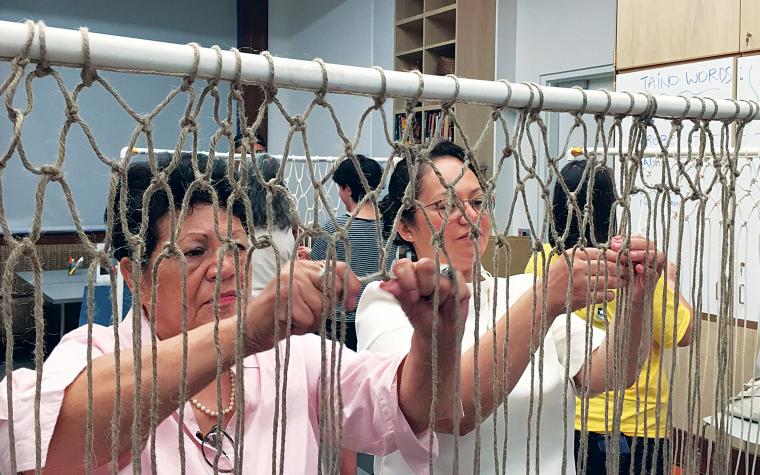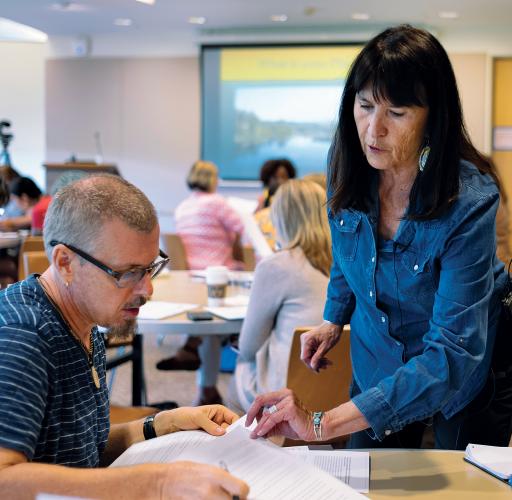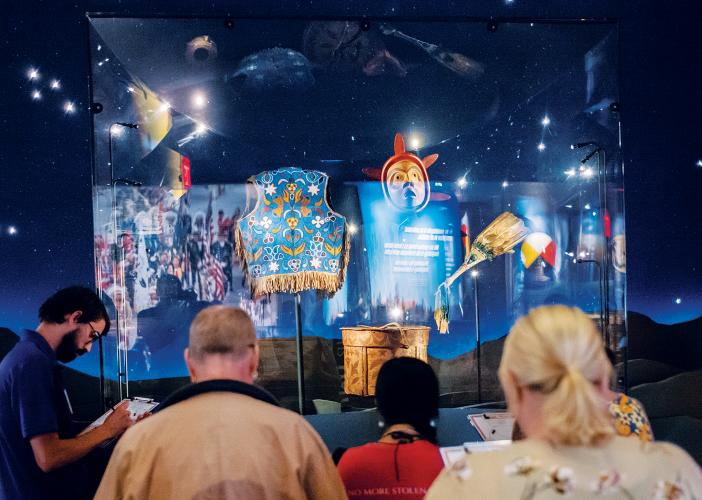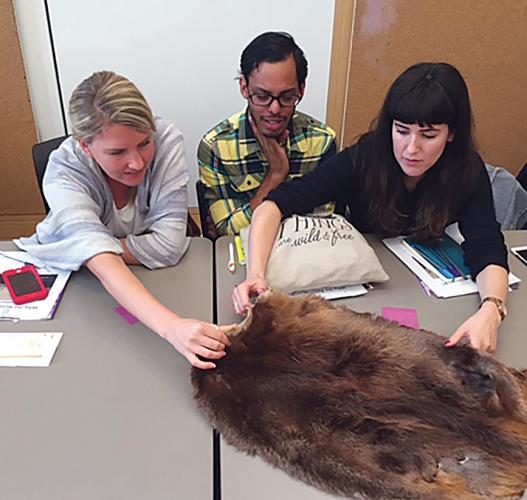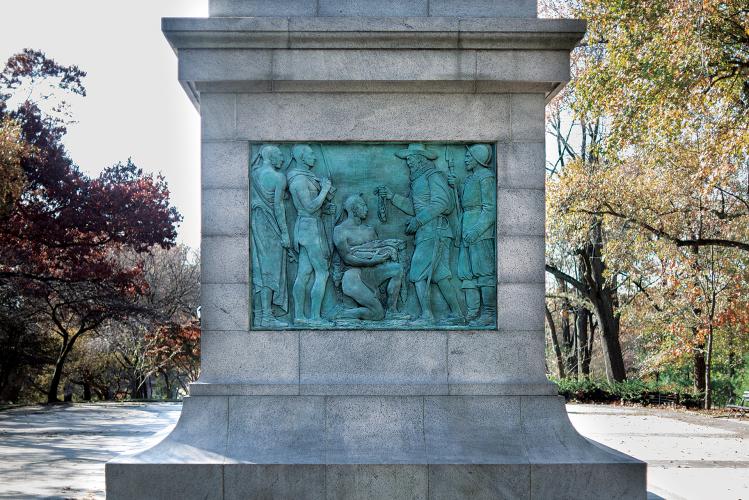At a public school in Seattle, Washington, Shana Brown is teaching American history. However, the topic isn’t the U.S. Constitution or the American Revolution. Brown, who is of Yakama and Muckleshoot descent, is leading her Robert Eagle Staff Middle School class in a lesson about the cultural, nutritional and spiritual connections people have with food.
It’s an active session. Brown and her students first talk about the ties between salmon and the Indigenous people of the Pacific Northwest. This leads to a discussion about how and why Native Nations take action to protect and sustain salmon and habitat. Students then discuss foods that are important to their own families and what they mean to their own identity. At the end of the lesson, Brown asks her students, “What do you think it would mean to Northwest Native people if the salmon were suddenly gone?” A student replies that this would “kill something deep down inside.”
Sharing Native Knowledge
The lesson, which Brown was teaching her class this past December, was from a teaching module entitled “Pacific Northwest History and Cultures: Why Do the Foods We Eat Matter?” She helped write this and other lessons about Northwest Native peoples for Native Knowledge 360° (NK360°), the National Museum of the American Indian’s national education initiative.
NMAI developed NK360° to help elementary through high school teachers incorporate Native American history, cultures and contemporary lives into their U.S. history, social studies and other curricula. Edwin Schupman (Muscogee), NMAI’s manager of national education, says NK360° looks deeper at “the real connections between Native American history and this place we call the United States.”
After opening its museum in Washington, D.C., in 2004, NMAI wanted to get the wealth of knowledge it holds about Native cultures and peoples into the hands of educators. The challenges, Schupman says, were, “How do we change problematic perceptions and practices that have been ingrained for centuries?,” as well as, “How do we reach teachers outside the museum? Our aspiration is to reach teachers and students everywhere.”
After several years of consulting with members of numerous Native Nations and educators, NK360° launched in February 2018. It now provides teachers with more than 30 teaching resources downloadable from the NK360° website (americanindian.si.edu/nk360). NMAI also offers workshops and other training opportunities for instructors to learn foundational information and discuss NMAI’s lessons with education staff and other Native experts so they can feel confident in using the materials.
“It’s a very exciting time for NK360°. Building on our earlier work, we will be releasing a steady stream of primary resources and other educational materials over the coming years,” says Michael Hussey, NMAI’s assistant director for Education.
While creating NK360° materials on the Pacific Northwest, NMAI education staff worked with educators and Native American communities in Washington state who had developed their Since Time Immemorial (STI) curriculum. STI was created in response to legislation that passed in 2005, which "strongly encouraged" Washington’s public schools to include the history and culture of Washington’s Indigenous Nations in the state’s history and social studies curriculum. NMAI began talking with those who developed the state curriculum, including Brown, one of the writers of STI.
STI was developed in consultation with the 29 federally recognized Native Nations in Washington state. NK360° was developed in consultation with numerous Native Nations and some 92 Native Nations are represented in the resources.
In 2019, Washington adopted NK360° lessons as part of STI, the first state to make NK360° part of its core curriculum. Schupman says that this is an indication that Washington state officials recognize the NK360° content as legitimate. “It meets requirements mandated by the state. It’s been vetted by education and cultural authorities, so it’s accurate. Teachers can use it with confidence.”
Changing Perspectives
Sarah B. Shear is assistant professor of Social Studies and Multicultural Education at the University of Washington–Bothell. She and colleagues from the University of Missouri analyzed U.S. history curriculum standards in all 50 states and the District of Columbia. In their 2015 article “Manifesting Destiny: Re/presentations of Indigenous Peoples in K–12 U.S. History” published in Theory and Research in Social Education, they reveal that the standards analyzed “overwhelmingly present Indigenous Peoples in a pre-1900 context and relegate the importance and presence of Indigenous Peoples to the distant past.” Further, since about 1900, U.S. history taught in public schools reflected U.S. policy toward its First Peoples: that the new Americans “settled the West” and “tamed the frontiers,” treaties were signed with tribes, and Native Americans moved to reservations or went to boarding schools, where they learned skills that enabled them to assimilate into the dominant population.
Shear says the long-used U.S. history curricula “provided justification for the reservations, for the boarding schools, for the genocide.” The truth is, she says, “The United States has always been a colonial power that views Native peoples as in the way.”
In developing NK360°, NMAI staff examined 18 elementary, six middle school and four high school textbooks to analyze how Native American culture and history was being presented to students. Common themes were the arrival of people across the Bering Strait land bridge, Indians as the “first inhabitants” of the Americas and intersections with selected explorers, colonists and “American history.”
The picture was grossly incomplete: most textbooks talked only about more commonly known Native Nations such as the Cherokee, conflicts with colonists such as the Indian Wars or other intersections with Europeans, and recognized figures such as Pocahontas. Few of the books presented American Indian perspectives on history or impacts on the colonists’ arrival on their lives or cultures.
Today, the broader, deeper discussions seen in Brown’s classroom are taking place more and more across the United States, showing that a sea change is underway in how American history is taught in public schools. Shear says an increasing number of states have state standards that require teaching of Native history. The National Congress of American Indians reports that 23 of the 28 states responding to its 2019 survey require the inclusion of Native history and culture in their history and social studies curricula.
Shear credits this movement to the growing economic and political influence of Native Nations, which was fueled by federal legislation in the 1970s and 1980s that cleared the way for economic development in Indian Country. In addition, Native educators and communities “are doing very powerful work from the ground up,” she says, to ensure their voices are heard and their peoples’ stories are accurately told.
Schupman says NK360° is correcting “some thoroughly ingrained misconceptions” and “encouraging teachers to reach out to Native communities. We see change happening.”
Value Beyond the Classroom
In Washington, you don’t have to look far for a reference to the state’s Indigenous heritage. People live and work in cities with Indigenous names like Seattle, Puyallup, Spokane, Tacoma and Walla Walla, and they fish and play in rivers with Indigenous names such as Hoh, Nisqually, Nooksack, Quinault and Skagit. Yet until legislation requiring the STI curriculum, Native culture was rarely discussed in classrooms.
Teachings that lack the voice of Native people can influence how non-Native people view and interact with their Native American neighbors, not only as youth but as adults. Some of these non-Native young people will grow up to become policymakers in city halls, state houses and the nation’s capital.
Kayla Guyett (Jicarilla Apache), Native literacy and culture specialist in the Highline School District near Seattle, says, “They were raised in a system that didn’t talk about it. But at this point in time, now we have resources. In the future, there won’t be any more, ‘That’s okay, that’s how you were taught.’ That will no longer be the case, and hopefully we will have better leaders.”
In Washington state, if someone doesn’t work in some way with a Native Nation, he or she may interact with a city council member or school board member who happens to be Native American. In Seattle, the largest city in Washington and 20th largest in the United States, the school district is led by Superintendent Denise Juneau (Mandan Hidatsa), the school board’s president is Zachary De Wolf (Chippewa Cree) and the vice president is Chandra Hampson (Ho Chunk). In addition, Debora Juarez (Blackfeet) serves on the City Council.
The growing economic presence of Native Nations in this state is also offering more opportunities for Indigenous and non-Native peoples to interact. Many Native Nations are the largest employers in their regions. In addition to schools, several own museums, golf courses and hotels. The Puyallup Tribe owns a prominent holistic cancer treatment center.
In Washington, STI and NK360° materials are now used concurrently in kindergarten through 12th-grade classrooms. By the time a student in Washington graduates high school, he or she is expected to understand some basic facts, such as more than 500 Native Nations exists within the United States, treaty rights supersede most state laws, and many landmark court decisions and legislation have affected and continue to affect Indigenous sovereignty.
Robert Eagle Staff Middle School Principal Marni Campbell says the STI and NK360° lessons can accomplish even more: “We’re in the business of creating opportunities for students to develop as humans. Math and science, those things are part of it, but the bigger framework is scholarship, ownership, academic focus and respect and responsibility. We emphasize that a lot—who we are becoming, what we are as a nation. That’s why it’s critical that we understand what this land is and what our place is in it.”
Empowering Teachers and Students
Schools that are using the STI and NK360° lessons say students are receiving a more thorough and accurate presentation of U.S. and Native American history and that, as a result, Native students are not only more engaged but empowered.
Guyett says Native American students who formerly couldn’t relate to curricula that ignored their cultures or inaccurately portrayed Indigenous people are now more in-tune to the lessons. “If you’re Native and no one has talked about your people before, you’re less willing to be engaged. It’s not applicable to you,” Guyett says. With NK360°, “the engagement is through the roof. [Students] feel empowered to go out and talk about these things and make a difference.”
At Robert Eagle Staff Middle School, Principal Campbell says social studies students now refer to “settlement” as “colonization.” We’ve taught that for years, that it was settlement, but it’s not,” she says. “We colonized, we took things away from people who were already here. That’s a mind shift. … It’s about rethinking who you are in your place. When we understand the power of the land, we begin to understand our own responsibility to it. And that applies to every single thing our students learn.”
This has been a win for schools and teachers. Gail T. Morris (Ahousaht), Native Education Program manager for Seattle Public Schools, says the graduation rate for Native American students was 52 percent when she joined the district in 2013. “Last year, it was 71 percent,” she says.
The world of non-Native students has expanded as well, as many now know that Native cultures are still thriving. “There’s been only one time when I had to correct a student that Native people should be talked about in present tense,” Brown says. “That would not have happened without STI and NK360°.”
In Brown’s classroom, eighth-graders Kai Seaton (Diné) and Ty Fleming talked about what they learned in an NK360° class.
“We got to learn more about where we’re from,” says Seaton, who lives in Seattle but spends summers with his family in the Navajo Nation. “We got to learn about the culture of the land we’re living in, not just general areas.”
Fleming studied about Washington’s dams and the effect on salmon populations, ate traditional foods and learned to prepare and weave cedar fiber. All of those things helped bring home the relevance of what was learned in the classroom—that Native cultures are not of the past but of the present.
“It’s been interesting and fun to learn about the people who are around me and their origin stories,” Fleming says. And even though different Native peoples have different origin stories, “it doesn’t mean they are wrong.”
Brown says incorporating Native history into her lessons has inspired her and her students. “I see the students’ world transforming— they see [American Indians] not as relics or as victims or as separate. That lights a fire in my belly.”
Learning to Teach Native Knowledge
Many teachers are not familiar with Native American history, or if they are, are not comfortable tackling some of the tough topics this entails, such as government assimilation policies, environmental changes that adversely affect Indigenous lifeways, and treaties and tribal sovereignty. NMAI’s NK360° connects educators nationwide with the resources they need to effectively teach such subjects in the classroom and beyond.
Essential Understandings
NMAI developed NK360° to dispel common assumptions about Native peoples—about their cultures, their roles in history, and their contributions to the arts and sciences. Its lessons show that Native cultures are not in the past but vibrantly alive today. Some 92 Native Nations from 17 regions in North, Central and South America are represented in NK360° materials.
Part of the core of NK360°’s resources is its “Essential Understandings,” basic knowledge about topics critical to Native people and their cultures. These subjects are not just history, social studies, government and civics but those that touch on many of the science, technology, engineering and mathematics (STEM) subjects, including astronomy, environmental science and geography. There are more than 30 downloadable lessons, among them “American Indian Responses to Environmental Challenges,” “The Inka Empire: What Innovations Can Provide Food and Water for Millions?,” “The Fish Wars: What Kinds of Actions Can Lead to Justice?,” and “Is a Treaty Intended to be Forever?”
“I love the rigor of the materials,” eighth-grade teacher Clarence Brantley Jr. of Statham, Georgia, told NMAI. “I love the fact that they provide a wide scope of the American Indian experience that I can use in my classroom to create a discussion about people’s past and present and how that impacts me and my students.”
Inspiring Teachers
NMAI hosts a variety of teacher workshops throughout the year and a multiday Summer Teacher Institute, during which educators learn basic concepts for understanding and teaching about Native Americans from NMAI staff and experts from Native communities, engage with exhibitions, receive instructional resources and create plans to integrate NK360° materials in their own classrooms. NMAI also offers a Teacher-in-Residence program in which a selected applicant spends eight weeks assisting staff with the development and testing of NK360° materials and training for educators.
Laura Lynn (Chickasaw ancestry/Eastern European/Syrian) is the program supervisor for the Office of Native Education in Washington state. She attended NMAI’s Teacher Training Institute in July 2018 and says the experience helped strengthen teachers’ confidence in teaching the lessons. “You find you’re not teaching about Native people, but in collaboration with Native people. You work with tribal educators and have full access to NMAI resources,” she says. “Once teachers see the organization and resources available to them, they feel very supported. You can see their excitement as they think about how to weave the curriculum into their instruction. Their creative juices start to flow.”
Erin Coppola-Klein, a middle-school teacher in Washington, D.C., agrees. “I left each day with important questions to ponder, exciting ideas and possibilities to try next year,” she told NMAI.
2016 Georgia Teacher of the Year Ernest W. Lee told NMAI that the workshop he attended “was a life-changing experience for me.” He says, “I am teaching U.S. history in an entirely different manner after having spent time at NMAI and being exposed to NK360°.”
Immersive Learning
This fall, teachers will be able to provide their students an immersive way to experience Native cultures. “Native New York,” a new exhibition scheduled to open at the NMAI in New York City this August, will offer teachers and their students an opportunity to explore how Native peoples shaped the history in what is now New York. Following a guided path on the floor, they will be able to literally walk through history, listening to recordings of Native people telling their own stories. NK360° is offering an accompanying lesson that can be used in or outside of the exhibition.
What is now New York is the ancestral home of the Lenape and Mohican Nations. After the Dutch arrived during the early 17th century, they began to build an extensive trade on beaver pelts, which they exported to Europe as part of its lucrative clothing market. The Dutch also wanted to acquire land. The Lenape and Mohican people, however, did not believe that land could be privately owned. In an exchange of gifts with the Dutch to welcome them, the Dutch thought the Indians sold Manhattan to them for what the Dutch valued as 60 guilders ($24) worth of trade goods. This myth has been perpetuated, even appearing on a mural displayed on a marker in New York’s Battery Park.
In the NK360° lesson, which is designed for third- and fourth-graders, the voices of Lenape and Mohican people help elementary students understand Indigenous values and concepts of trade and land ownership. It also emphasizes that Native people are very much a part of New York today.
In the curriculum, Curtis Zunigha, director of Cultural Resources for the Delaware Tribe, explains to students, “We are the descendants of the original Lenape people of ‘Mannahatta,’” he says. “I work to preserve and honor the culture and history that our ancestors have passed down over the generations.” Zunigha explains in words and images examples of traditional Lenape regalia and what the colors and materials represent as well as the meaning behind the movements in a traditional Lenape dance.
Johanna Gorelick, NMAI’s manager of education services in New York, says that this new teaching module and the rest of NK360°’s materials bring these often-unheard voices into the learning environment. “In elementary school, there is a dearth of materials on the Native perspective,” Gorelick says. “A lot of teachers are hungry for this."
Find out more about NK360° and download its resources at americanindian.si.edu/nk360.

